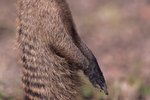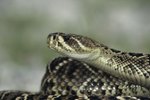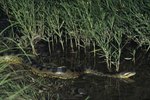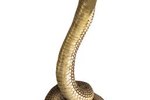Anacondas are the longest snakes in the world and can live up to 30 years old while growing up to 550 lbs. These snakes are known to inhabit marshes and swamps within the Amazon rainforest where they wait for unsuspecting prey. Anacondas can move quickly in the water and coil around animals both large and small. Because of the anaconda's size and strength, it has very few natural predators.
Jaguar
The jaguar is the largest mammal in South America, growing up to 250 lbs. Jaguars are well known for their swimming ability, which puts them in regular contact with the anaconda and its aquatic habitat. If a jaguar encounters an anaconda, it may fight back in self-defense, however, it would rarely prey on the anaconda due to the size and tenacity of the snake. When and if the jaguar does kill an anaconda, it would do so with bites to the head, neck or throat. The jaguar has the strongest biting force of all cats around the world, with up to 2,000 lbs. of force in its jaw.
Humans
The most dangerous opponent for the anaconda is the human population. As the Amazon River basin and other rainforest and wetland areas are lost to new development and construction, the habitat for the anaconda disappears, forcing it to flee to find a new habitat or perish. Due to its size, anacondas are also hunted and poached for its valuable skin, which is used to make purses, boots, belts and other leather-bound objects. Locals and natives also fear the anaconda and regularly kill the snake to protect livestock or out of fear, although reports of anacondas attacking humans are rare.
Small Anacondas and Babies
Anaconda newborns are typically 2 to 3 feet long and are sent out on their own from the moment they are born. As a result, other predators, such as birds, jaguars, other jungle cats and caimans may prey on young snakes until they are a few years old, when they are large enough to deter the predators themselves. Other predators of anacondas within their first two years of life include crab-eating foxes, tegu lizards and crested caracaras. Larger green anacondas have also been known to kill and eat juveniles.
Other Predators
Other aquatic predators may prey on weaker anacondas, such as babies or snakes that are old and sick. Large groups of piranhas may gang up on an older, weaker anaconda near the end of its life. Caimans, which are smaller members of the alligator family may also prey on smaller or weaker anacondas, although, when the anaconda is full grown, it is known to prey on the caiman.
References
Resources
Photo Credits
-
Medioimages/Photodisc/Photodisc/Getty Images
Writer Bio
David McGuffin is a writer from Asheville, N.C. and began writing professionally in 2009. He has Bachelor of Arts degrees from the University of North Carolina, Asheville and Montreat College in history and music, and a Bachelor of Science in outdoor education. McGuffin is recognized as an Undergraduate Research Scholar for publishing original research on postmodern music theory and analysis.





